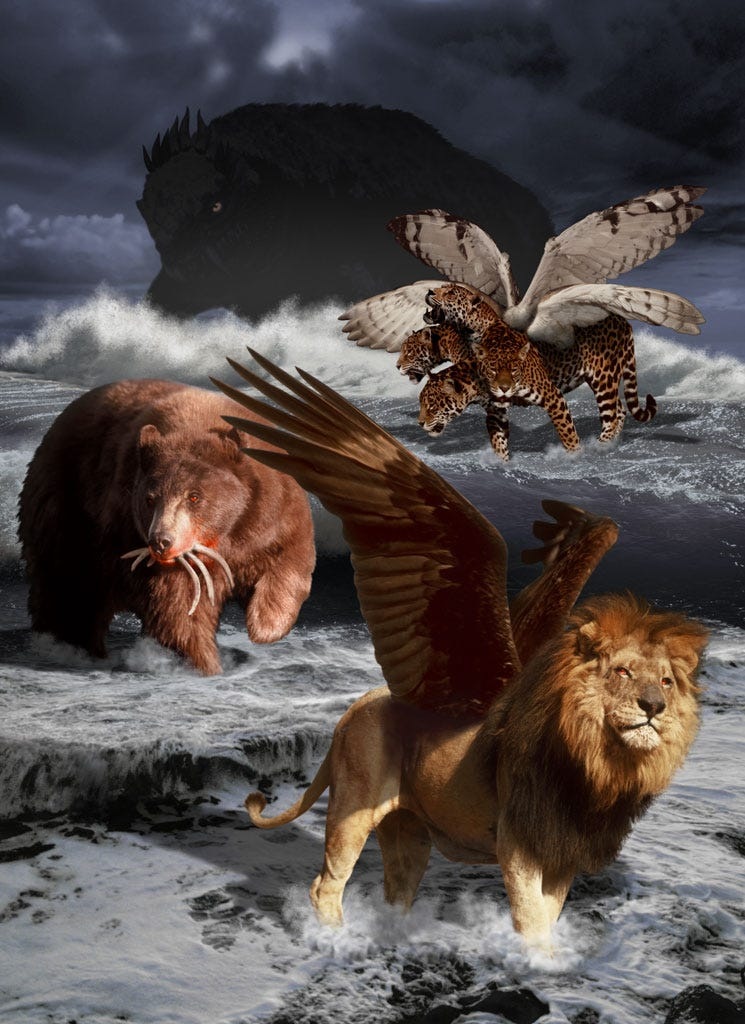

[1] In the first year of Bal-asha-tsar king of Babal: Danay’al, a dream he saw, and vision in his head upon his bed. Then the dream he wrote, the sum of the matters he told.
[2] Spoke Danay’al and he said: Seeing was I in my vision by night, and behold, the four winds of the heaven strove upon the sea great.
[3] and four beasts, great ones, came up from the sea, different this from this.
COMMENTARY OF DANAY’AL 7:1-3
[Verse 1] The prophet Danay’al obviously witnessed and experienced this dream in his own head in his own native language of Ghabaray and wrote it down in that language, but because he was appointed the “master of magicians,” and the chief interpreter of dreams, in the royal Babylonian court, he was required to prepare a translation into the Aramaic tongue for the benefit of his Babylonian lord, King Bal-asha-tsar, the son and successor of Nabo-chadar-atsar (Nebuchadnezzar II).
No king who went by the name Bal-asha-tsar ever sat upon the throne of Babylon during the entire Neo-Babylonian period, and thus we are inclined to see that Bal-asha-tsar was not any Babylonian king’s royal name but was rather the original name of a son of Nabo-chadar-atsar prior to his confirmation as heir to the throne. The only king this could be is Amel-Marduk (562-560 BCE) who came to the throne ca. 563 BCE in the lifetime of his father Nabo-chadar-atsar.
There is scholarly opinion that Amel-Marduk was not this king’s original name, with some believing his name at first was Nabu-shum-ukin. But as this attested prince, imprisoned on grounds of conspiracy, is known for not being Nabo-chadar-atsar’s eldest son, nor was he even the oldest living son at the time of his supposed appointment as crown prince and heir, we dismiss this proposal as highly improbable.
It appears Nabo-chadar-atsar was particularly fond of Babylonian theophoric names like Bal-tasha-tsar (Belteshazzar, “prince of Bal”), according to Danay’al 4:8, because they were in accordance with the name of his principal god Marduk who was called by the title Bal (Bel, “lord”). Bal-asha-tsar (Belshazzar, “prince of Bal”) evidently changed his name to Amel-Marduk (“man of Marduk”) because the new name employed the actual name Marduk instead of the god’s honorific title. The two names Bal-asha-tsar and Amel-Marduk mean essentially the same thing.
Evidently the succession to Nabo-chadar-atsar became problematic while the king was in a state of madness for seven “times” (Danay’al 4:16, 25) and these days were prone to political instability. When the king recovered from his period of insanity ca. 566 BCE is the likely time at which his eldest son Bal-asha-tsar changed his name to Amel-Marduk. The crown prince would have been expressing both gratitude and reverence towards the god Marduk for his father’s full recovery, the same god to whom he and his father Nabo-chadar-atsar were the most ardent devotees. Not only was the stability of the kingdom secured after Nabo-chadar-atsar regained his senses (Danay’al 4:36) but the succession of Amel-Marduk was all but guaranteed when he was officially named heir to the throne by his father.
The very late and long after the fact accusation that Amel-Marduk dishonored his father after his father’s death by reversing his father’s decrees and having his father’s dead body dragged through the streets of Babylon is nothing but unsubstantiated and conflicting Jewish myths (see for example their Seder Olam Rabbah xxviii, written in the 2nd-century CE; their midrashic text called Levitcus Rabbah, xviii. 12, written in the 5th-7th-century CE; and also their Chronicles of Jerahmeel, written in the 12th-century CE). The reliance upon such erroneous accounts from very late Jewish midrashic literature in order to reconstruct ancient Neo-Babylonian history is tacitly unsound and absurd.
[Verse 2] Having learned the Aramaic language during the time of his captivity in Babylonia, the prophet Danay’al was able to “speak” his dream out loud in the presence of the king in the language of Aramaic that the king and the other members of his court understood. His dream touched upon the fate of the Neo-Babylonian regime, and thus by its very nature was an official matter of government interest. Since it is an official address made before the king and his royal court, and it carries a royal date-line in the king’s name, it is the version Danay’al incorporated into his book.
Danay’al begins by saying that he saw the four winds striving upon the great sea. The sea in this case refers not to the Mediterranean Sea, but to the great sea of the nations of peoples. The raging of the winds from the four quarters of the heavens points to the various political and social agitations which the angels from heaven are charged with manipulating in order to orchestrate the world’s history, which leads to the changes and revolutions that fulfill the will of the Creator who reigns supreme in all of the affairs of mankind (Danay’al 4:34-35).
[Verse 3] Danay’al saw four great beasts, differing from one another, ascending in succession from the raging great sea.
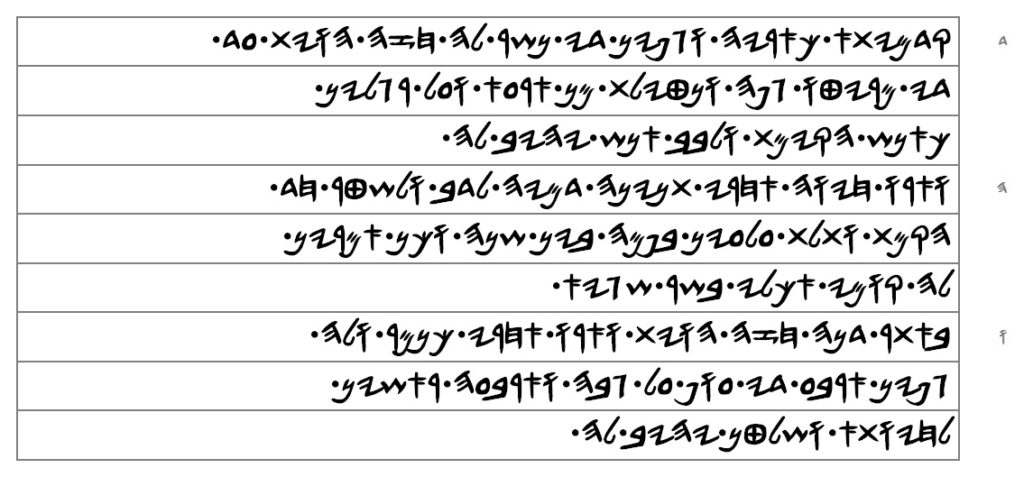
[4] The first, a lion, and wings of the eagle it had. I beheld and I saw till they were plucked up, the wings of it, and it was lifted up from the earth, and upon the feet like a man was it made to stand, and the heart of a man was given to it.
[5] And behold a beast another, a second, like the bear; and on one side was it raised up; and three ribs in the mouth of it between the teeth of it: and thus they said to it, rise up, devour flesh much.
[6] After this I beheld, I saw, and lo, another like a cheetah; and to her, wings four of a flying creature upon the back; and four heads were to the beast, and dominion was given to her.
COMMENTARY OF DANAY’AL 7:4-6
[Verse 4] The first beast in the vision concerns a lion-like kingdom and not an individual man. This kingdom corresponds to the ‘head of gold’ in Danay’al 2:32, 37-38. The kingdom’s wings are taken away, i.e. it is deprived of the power of flight and its swiftness of conquest is stopped. It is then lifted up into an erect position like a man, and receives a man’s heart.
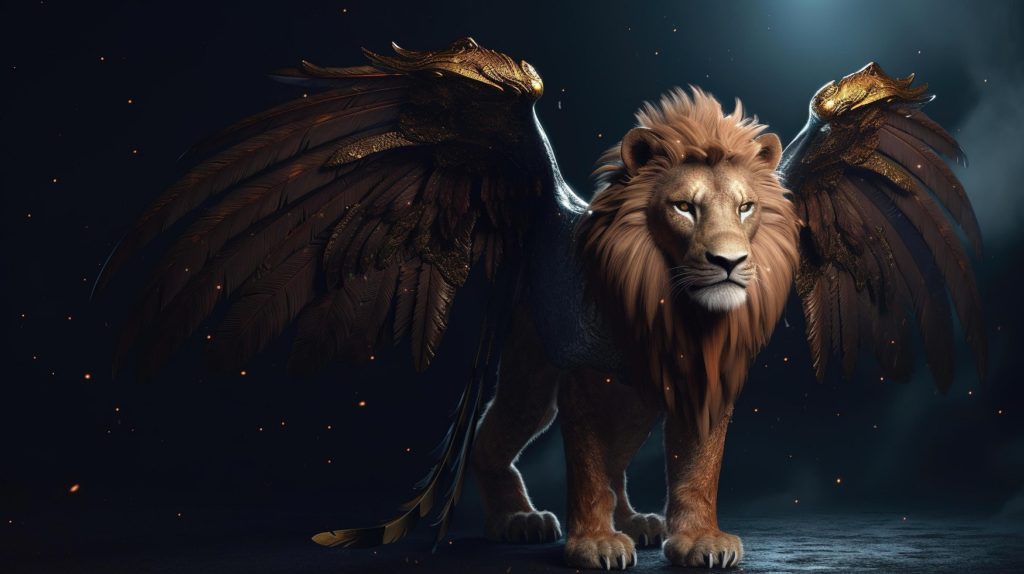
There are in fact two Babylons. The first, ancient Babylon, was located east of the promised land and had the character of a lion with wings. The second, the daughter of ancient Babylon, is located in the far north country. The ancient city in the east died a very slow death as it fell into ruins through centuries of neglect. It was never violently destroyed by the Persians, nor by any subsequent power. It simply died by growing old and becoming an abandoned dilapidated ruin over time. However, the daughter of Babylon in the north country is none other than the United States of America in North America, the strongest nation in human history. It is this Babylon that was made to stand upright like a man which gives to it the facade of being civilized, peaceable, and humane. Yet it remains a dangerous wild animal in reality.
That it was given a man’s heart points to the United States of America becoming the most intelligent, the most advanced, and the most technologically sophisticated nation ever to appear on earth. The old outward character of the empire has disappeared, but the modern representative that puts up the front of being humanized is far more deadly.
[Verse 5] The kingdom denoted by the bear corresponds to the ‘silver’ chest and arms of the great statue in Danay’al 2:32, which was ‘inferior’ to that of Nabo-chadar-atsar (Danay’al 2:39). After conquering the Median kingdom in 550 BCE, the Persian monarch Cyrus the Great led the Persians to conquer the Lydian kingdom in 546 BCE, and the Neo-Babylonian kingdom in 539 BCE. These are the three ribs in the mouth of the bear which became provinces of the Persian Empire. The bear began with one side raised up and this signifies that the Persian Empire established by Cyrus the Great was initially his dynasty of Anshan, but Cyrus’ successor Daray’osh Hystaspes (509-473 BCE) overthrew the house of Anshan and established the older dynasty of the Achaemenids as rulers of the Persian Empire. Cyrus was in fact unrelated to the Achaemenids. His family was of Persian Teispid and Anshanite origin instead of Persian Achaemenid.
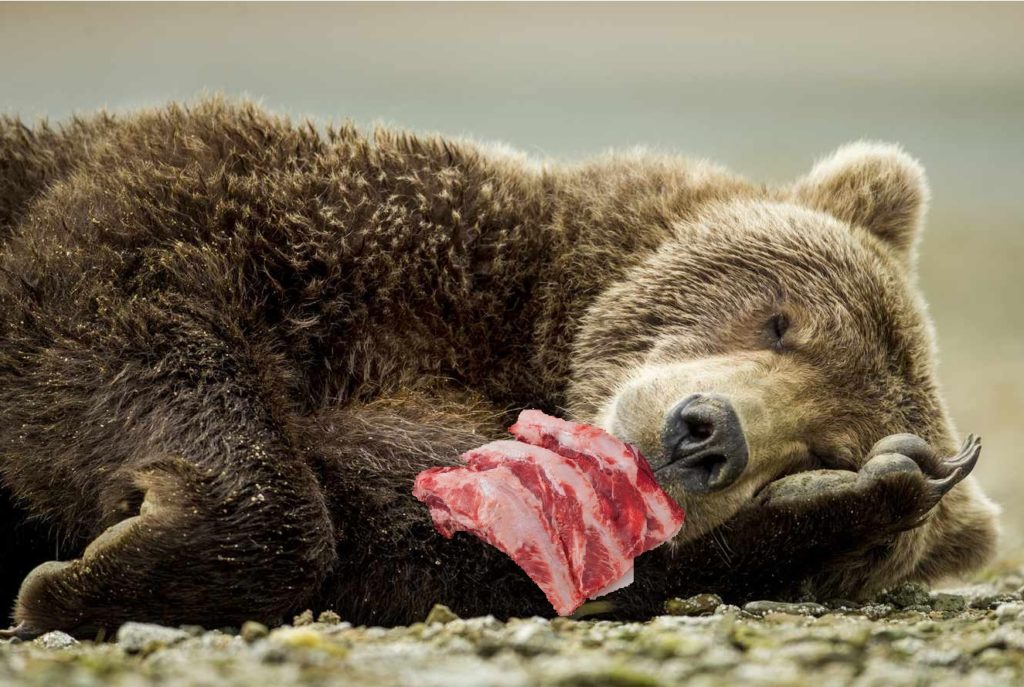
The bear rising up and devouring much flesh after it had turned Media, Lydia, and Babylonia into provinces of the Persian Empire refers to the Persian Empire reaching its largest territorial extent under the Achaemenid regime of Daray’osh Hystaspes. His rule stretched from the Balkans (Eastern Bulgaria–Paeonia and Thrace–Macedonia) and the rest of Southeast Europe in the west to the Indus Valley in the east. Daray’osh Hystaspes was also the fifth king of Persia mentioned in Danay’al 11:3. His four Persian predecessors were the Persian kings of the dynasty of Anshan: Cyrus the Great, Cambyses, Bardiya, and Vahyazdata.
[Verse 6] The third beast is a ‘leopard’ in most translations, but the namar is more correctly the cheetah, the world’s fastest land animal. On the great vigilance and swiftness of the cheetah compare Yaram-Ya’oh (Jeremiah) 5:6; Hoshai (Hosea) 13:7; and Khabakok (Habakkuk) 1:8. This third kingdom corresponds the ‘copper’ belly and thighs of the great statue in Danay’al 2:32, 39. Four wings on the back of the cheetah denoting swiftness is a fitting image of the Greek Empire and Alexander the Great who astonished the world by the great speed of his military victories in all directions.
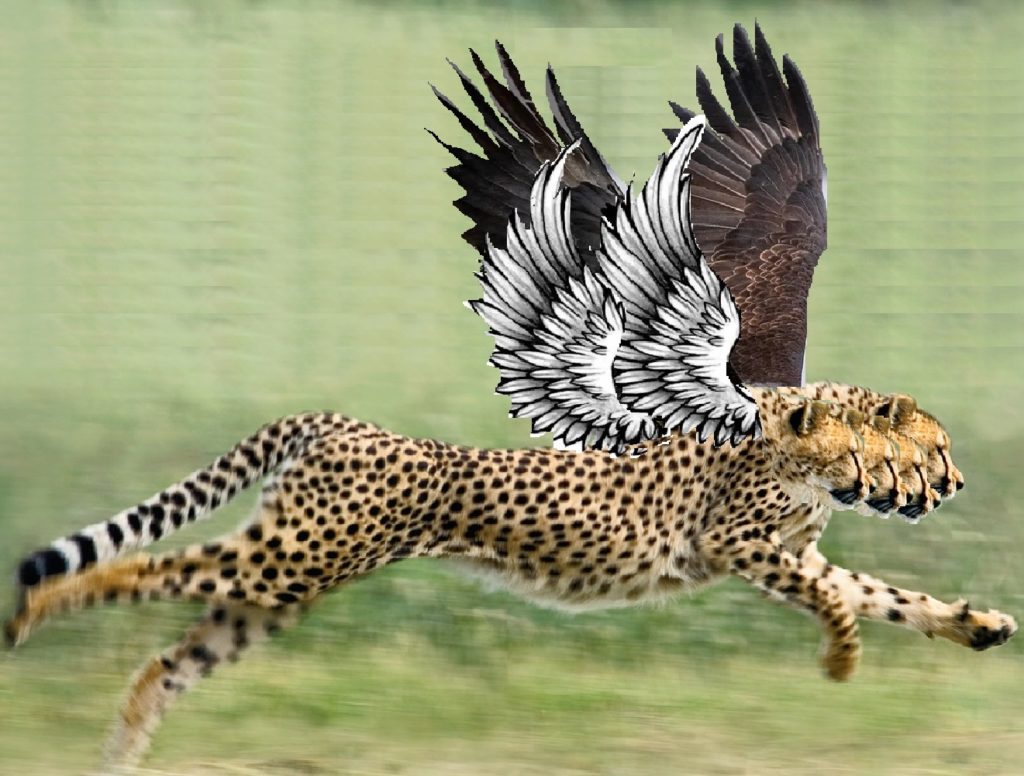
Alexander’s death in 323 BCE was sudden and his empire disintegrated into 40 years of war and chaos between the so-called “Successors” (Diadochi) of Alexander. The Hellenistic world eventually settled into four stable power blocks: the Ptolemaic Kingdom of Egypt, the Seleucid Empire in the east, the Kingdom of Pergamon in Asia Minor, and Macedon. These are the four heads of the cheetah in the vision as well as the four horns of the Greek Empire in Danay’al 8:8, 22.
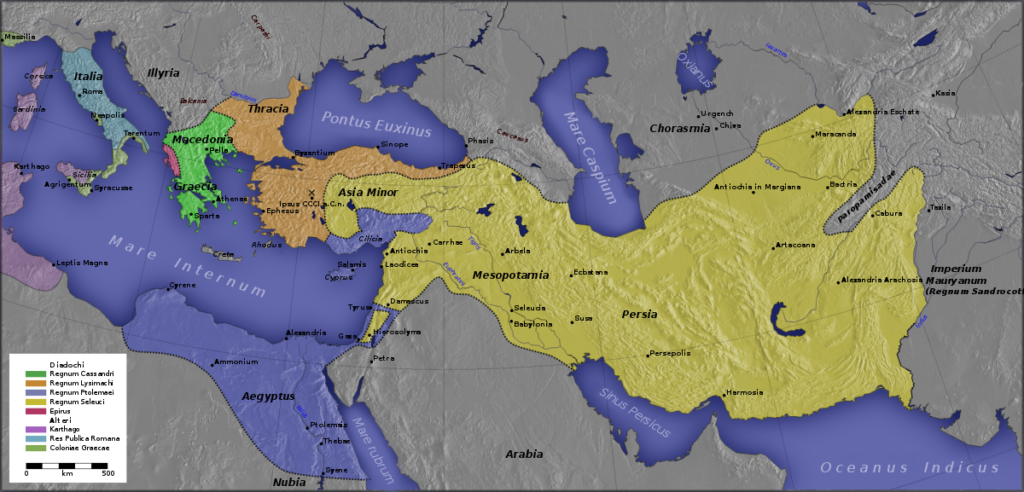
Different generals of Alexander got control over different areas of the empire. Ptolemy I Soter, took control over Egypt and he founded the Ptolemaic Kingdom. Another general, Cassander, took control over mainland Greece. Lysimachus was one of Alexander’s bodyguards and he was also a member of the Companion Cavalry. He took control over Thrace and Asia Minor. Seleucus I Nicator was one of Alexander’s generals and he took control over the Middle East and Central Asia. He by far had the most amount of territory under his control.
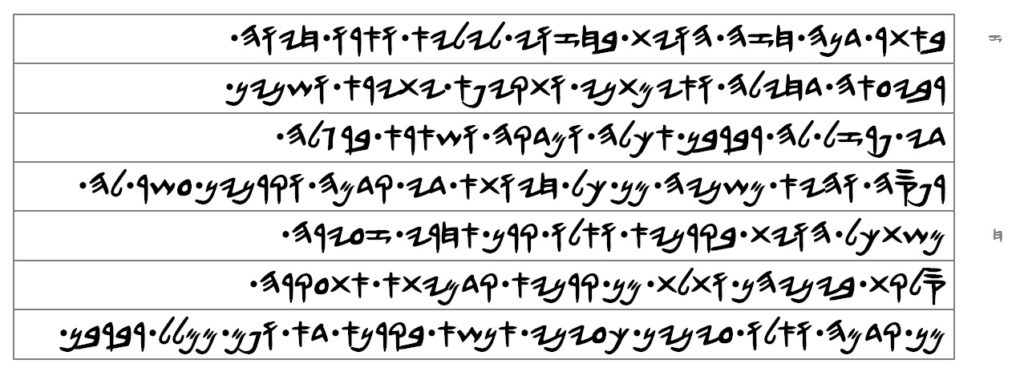
[7] After this, I saw, I beheld in the visions of the night, and behold a fourth creature, dreadful and terrifying, and strong exceedingly, and teeth of iron she had; great things she devours, and she breaks into pieces the residue by the feet of her and she stomps; and she is different from all the beasts that are before her, and she has ten horns.
[8] I considered, I beheld in the horns, and behold another horn, a little one, she came up among them; and three from the horns of the first ones were uprooted from before her; and behold, eyes like the eyes of a man are in this horn, and a mouth speaking great things.
COMMENTARY OF DANAY’AL 7:7-8
[Verse 7] The fourth beast-kingdom is a nondescript animal, something that has no counterpart in nature to compare it with. This is the Roman Empire which indeed was different from all three of the preceding kingdoms, having the most dreadful, the most terrifying, and the strongest military the world had ever seen. The iron teeth of the fourth beast corresponds to the ‘iron’ legs in the fourth section of the great statue in Danay’al 2:33, 40.
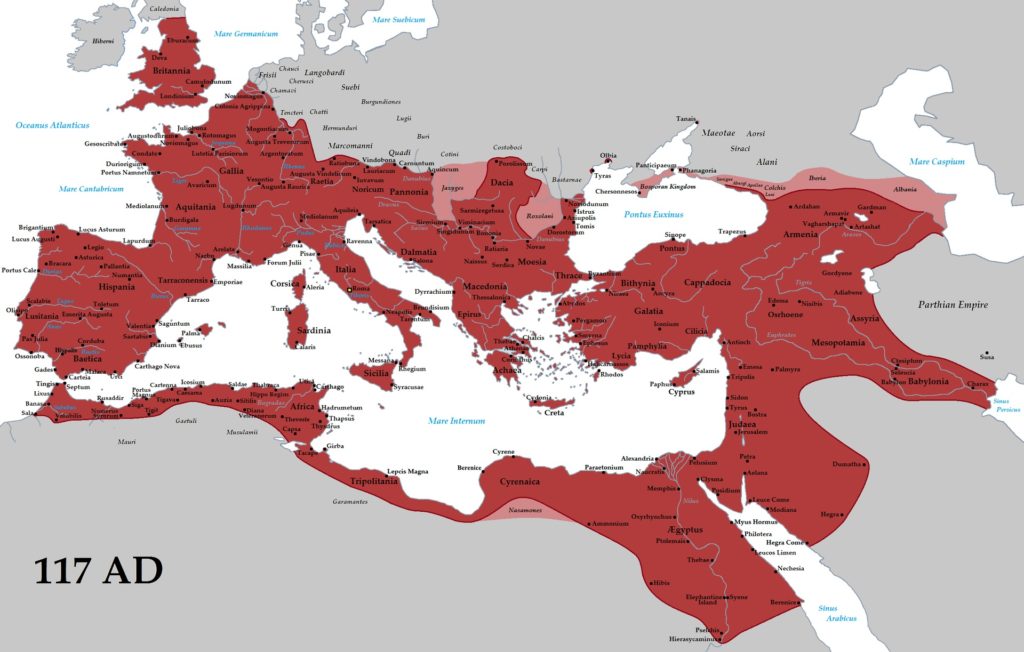
The Roman Empire turned itself into Christendom in 4th-century CE when Constantine made Christianity the official religion of the state. It is therefore historically incorrect to say that Rome was no more as of 476 CE. The empire merely changed clothes. Odoacer, a commander of the Roman armies, deposed the last of the Roman emperors in 476 CE and became the first German ruler of Rome. It was still Rome, still Christendom, it just began a new phase of its history. Christendom entered a fractured period with many different principalities rising and falling in Europe. The dress changes over the centuries is how we eventually ended up with nation states in Europe, but it’s still Rome, still Christendom, and most of it still looks to the spiritual guidance of the Roman church even if they are Protestant.
The ten horns of the fourth beast correspond to the ten ‘toes’ of the great statue in Danay’al 2:42. These are ten kings according to Danay’al 7:24. Most of the nations of Christendom are now Republics which have abolished their monarchies. However, there are ten hereditary monarchies that still remain: England, Spain, Sweden, Norway, Netherlands, Monao, Luxembourg, Liechtenstein, Denmark, and Belgium. We are currently living in the days of the feet with ten toes on the great statue of King Nabo-chadar-atsar. To be more clear, the feet of the great statue are those European nations without monarchies, and the ten toes/horns are those European nations that still have their hereditary monarchies.
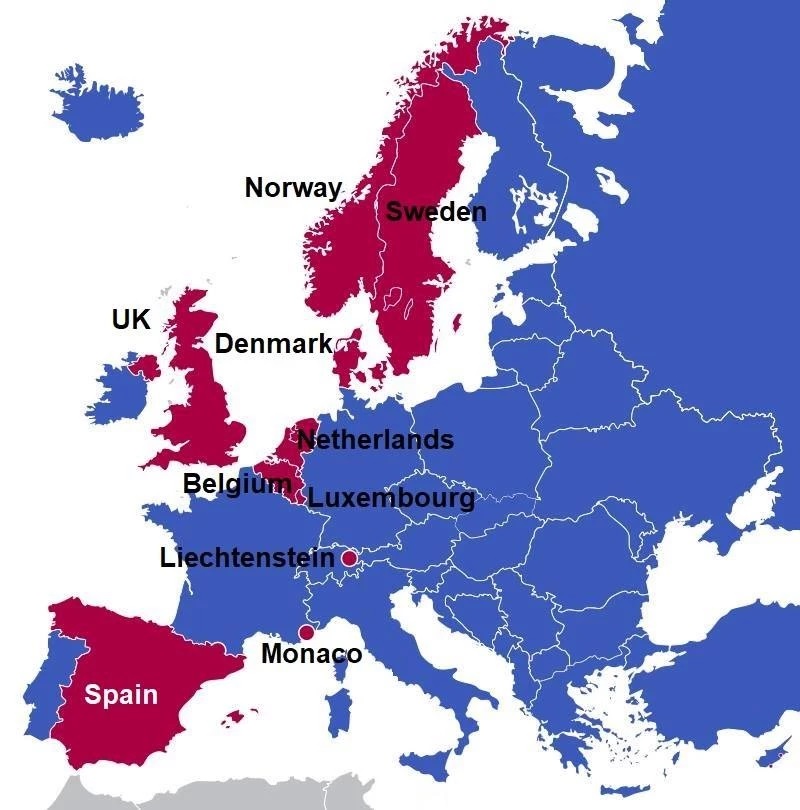
[Verse 8] The little horn that comes up from among the ten is clearly a newbie, a Johny-Come-Lately newcomer among nations, but she is able to uproot three of the first horns. This is the United States of America. During her rise to world dominance she defeated England in the American Revolution (1775-1783), Spain in the Spanish American War (1898), and also Liechtenstein when it sided with the Austrian Empire (Austro-Hungarian Empire) during World War I (1914-1918).
The United States of America began to be seen as a world power for the first time after its participation in World War I. In World War II (1939-1945) the United States emerged as a superpower alongside the Soviet Union. After the Cold War with the Soviets (1947-1991) the United States emerged as the world’s only superpower with the strongest military of any nation or empire ever witnessed in human history. Her unparalleled dominance in every aspect of human society is why she is the daughter of Babylon. The baton of ancient Babylonian supremacy has been passed to her daughter.
The little horn has eyes of a man and a mouth that speaks great things. This is the second time in the vision where a beast has human abilities that animals do not possess. The reason is because these two parts of Danay’al’s vision are in fact one and the same. When the lion was caused to stand upright and it was given a man’s heart it foreshadowed the little horn with its eyes and mouth. The little horn with eyes and mouth is the same lion after it was caused to stand upright and was given a man’s heart.
The heart and eyes of a man indicate intelligence and keen insight. They are what set him apart from the animal world. A mouth that speaks, something no animal cannot do, and not just speak but also speak great things, indicates an articulate voice that speaks louder and with more power than other mouths. The beast with human attributes is the daughter of Babylon, i.e. the United States of America.
What nation has ever possessed equal or better vision and insight, and has spoken with a mouth as loud or louder, than the United States of America? America’s insight and voice in the world are preeminent and unquestioned. They are pronounced in every facet of power – military, economic, technological, cultural, and moral. It is the strongest military force the world has ever known. The U.S. defense budget is more than what the next fifteen nations after it spend combined. There is simply no challenger to U.S. world dominance, and it is the stated policy of every American President to keep things that way.

[9] I beheld, I saw until thrones were thrown down, and the Ancient One of Days did sit, His garment white like snow, and the hair of His head like pure wool. His throne is a fiery flame, its wheels a burning fire.
[10] And a river of fire issues and comes forth from before Him: thousand of thousands will serve Him, and ten thousand of ten thousands before Him will stand. The judgment will be set, and the books were opened.
COMMENTARY OF DANAY’AL 7:9-10
[Verse 9] “The Ancient One of Days,” i.e. YA’OH, will throw down thrones, meaning He will topple governments and destroy the nations of the world, and all of their armies (Yashai-Ya’oh 34:2), during the wonder years of a time, times, and a half. YA’OH will sit supreme upon His throne in the world. It will be judged and destroyed by Him during this time via the remnant of Ya’oh-shar-al that He gathered to the second wilderness just before the wonder years commence (May’chah 4:13). Babal and Adom will be the primary targets (Yashai-Ya’oh 13:1-22; 34:1-17).
The wonder years will be so catastrophic for the people who are not part of the remnant nation in Mount Tsay’on in the wilderness that the vision highlights at this point the white color of the Ancient One of Days’ garment and also the wooly texture of His hair (pure unbleached wool is not white, but has a natural off-white hue). Both indicate the unspotted righteousness of His acts and the purity of His judgments at this time despite how things will look outwardly as millions die horrific deaths without any mercy being extended to them. His throne is not always seen by the prophets as a fiery flame, nor its wheels, which were also described by the prophet Ya’oh-khazak-al (Ezekiel), a burning flame. But now they are because this is the day of His vengeance and the day of His great wrath.
[Verse 10] A river of fire issues and comes forth from before YA’OH. This is not literal but the question is where is this deadly river going. The answer is that the river of fire is symbolic and represents His judgments that will manifest in the form of meteorological catastrophes and natural disasters, a continuously flowing river of destruction worldwide. It will issue forth from Him and descend upon the ungodly at the behest of His redeemed remnant in the wilderness during the wonder years. The many thousands of angels who serve YA’OH and who stand before His throne are not just standing there doing nothing. They are receiving their assignments, as they will be the ones sent out by YA’OH to cause the natural disasters and calamities around the world. Everything will be done according to the judgments of YA’OH contained in His books wherein meticulous records of wrongdoing and the punishments to be meted out for them have been recorded.

[11] I beheld, I saw then from the voice of the words, great ones of the horn, that she spoke. I beheld, I saw until she was slain, the beast, and it was destroyed her body, and she was given to the burning flame.
[12] As for the rest of the beasts, they had it taken away their dominion, yet their lives were extended until a season and time.
COMMENTARY OF DANAY’AL 7:111-12
[Verse 11] The little horn in the vision is not an individual man. Rather, “she” is a nation of people. She sprang from the peoples of Christendom Europe, i.e. the feet of the great statue of Nabo-chadar-atsar, which is part iron (strong) and part earthenware (weak), and now has only ten hereditary monarchies. These ten are the ten toes of the great statue of Nabo-chadar-atsar. The fourth kingdom upon earth in its final hours is the little horn (the United States of America), Christendom Europe, and Christendom Europe’s ten monarchies. All will be destroyed, meaning the city of modern-day Babylon and all of Christendom Europe will be overthrown by the same fire that will issue forth as an unstoppable river from the throne of YA’OH in the day of His vengeance. It is the same fire that will be summoned forth by the pure arrows that will be aimed and shot at Babal from a distance by the mouths of the remnant of Ya’oh-shar-al in the wilderness.
[Verse 12] The first beast was never destroyed. It merely changed its rulers from Babylonian to Persian in 539 BCE, and it continued changing rulers until it slowly died of natural causes over the course of centuries from neglect and abandonment.
As for the second beast, Alexander defeated Darius III (IV) in 330 BCE, but the Parthian Empire and the subsequent Sassanid Empire prolonged the life of the Persians as a major power until the Arab conquest of Persia in the 7th-century CE.
As for the third beast, its Macedonian head was absorbed into Rome in 146 BCE. Its Anatolian head in Asia Minor was given to the Roman Republic in 133 BCE. The Seleucid head became indebted to Rome with the Treaty of Apamea in 188 BCE, and was later completely absorbed by Rome in 63 BCE. The dynasty of the Ptolemies came to its end in 30 BCE. Octavian became the sole ruler of Rome at this time and began converting it into a monarchy, the Roman Empire.
Who would be foolish enough to say that although the dominion of the Greek Empire with its four heads was gradually taken away by the Romans its life ceased and no longer lives today? Hellenism (Greek: Ἑλληνισμός) actually refers to the Greek language and not to any ancient Greek religion. After the Roman conquest of Greece, an unofficial bilingualism of Greek and Latin was established in the city of Rome and Koine Greek became the first or second language in the Roman Empire. Latin has died out but Greek is still alive.
As for the fourth beast, its life and its dominion will come to an abrupt and cataclysmic end at the same time according to verse 11. There will be no prolonging of its life as we have seen with the preceding three beasts.

[13] I beheld, I saw in the visions of the night, and behold, with the clouds of heaven, like a son of man was he come, and to the Ancient One of Days he came, and before Him they brought him near.
[14] And to him was given dominion, and glory, and a kingdom, and all nations, and peoples, languages, to him will they serve. His dominion is a dominion everlasting which will not pass away, and his kingdom will not be destroyed.
COMMENTARY OF DANAY’AL 7:13-14
[Verse 13] What the prophet Danay’al saw in the night visions at this point was either an individual man riding upon literal clouds, or a particular people traveling through the sky and depicted symbolically as an individual man. We are not there yet but verses 18 and 27 give the correct answer. If the son of man in this vision is a single man, why does he disappear completely in the explanation of the vision given by the angel to Danay’al in verses 15-27?
The son of man coming with clouds in this vision is a group of people and not a single individual. This people will fly to a place on earth where the Ancient One of Days sets His throne. It is the place from where He will be dishing out judgments upon the world based upon the contents written in His books. “They” brought him near, meaning the angels who minister to YA’OH facilitated the transportation of this people to the place of the throne in order for them to be near YA’OH, the Ancient One of Days. Chief among these angels is our brother, the ruler who was created in the days of old and was born a human in Bayth-lakham to the family of Do’ayd (May’chah 5:2). He comes like a thief in the night to orchestrate the stealing away of the remnant to take them out of harm’s way, i.e. out of the way the river of fire issuing from the throne of YA’OH, and bring them to the source of the river of fire itself in the second wilderness, which will be the only safe place on earth. A good thief is never seen and that is why the Exodus of the remnant to the second wilderness currently underway is not seen by the masses for what it really is.
The clouds in this vision are not literal clouds. They represent the mode of travel. These are man-made vehicles that propel themselves and the passengers on board through the air. This is how the remnant of Ya’oh-shar-al make their Exodus from the land of the north, and from other lands, and come to the second wilderness in the east where YA’OH has announced the place of His throne by calling a ravenous bird to proclaim His name from that place (Yashai-Ya’oh 41:25; 46:11). They get there by flying (literally) on the wings (figuratively) of a great eagle (Khazon 12:7 [14]).
[Verse 14] We know from other prophecies that the mashaykh (messiah) who descends paternally from Do’ayd will one day sit upon the throne of Do’ayd and reign for ever (Yashai-Ya’oh 9:6-7). Verses 13-14 are not negating this fact. The kingdom of YA’OH is first restored by the people who make up the remnant of Ya’oh-shar-al in the second wilderness. This is before the mashaykh comes. When the period of a time, times, and a half has run its course the remnant, who will have become a mighty people during that time in the wilderness, will transfer the kingdom from the wilderness to the promised land in the Levant. The mashaykh does not come to receive the kingdom until after the people of Ya’oh-shar-al have reclaimed the promised land.
In fact, the mashaykh does not come until the resurrection of the dead which will not happen until after the war with Gog of Magog in our land. The mashaykh will be the one who sits and judges those who have been resurrected from death. He will determine which ones will enter the kingdom and which ones will not (Mathath-Ya’oh 25:31-46). This is the moment of judgment when the mashaykh smites the earth with the rod of his mouth and slays the wicked by the breath of his lips (Yashai-Ya’oh 11:4). The first death is not a true punishment. Everybody dies and is gathered to sha’ol, righteous and unrighteous alike. The second death for the resurrected unrighteous is an eternal punishment (Danay’al 12:2).
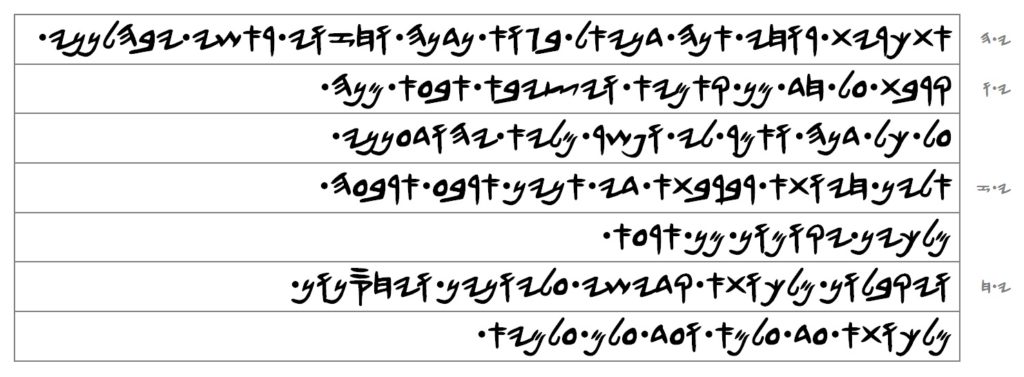
[15] I was upset in my rokh, I Danay’al, in the midst of the sheath, and the visions of my head, they troubled me.
[16] I came near unto one from the ones standing by, and the truth I asked from him about all of this. And he spoke to me, and the interpretation of the things he made me to know.
[17] These great beasts which are four, four kingdoms will arise from out of the earth.
[18] And they will receive the kingdom, the saints of the One Above All, and they will possess the kingdom for ever, and for ever the evers.
COMMENTARY OF DANAY’AL 7:15-18
[Verses 15-18] The Aramaic word nidnay means “sheath,” “vessel,” receptacle” (fig., body). Hence the body is a sheath for the rokh or soul. Danay’al was not distressed in his rokh within his sheath because he did not understand the vision. The angel explained the vision to him so that he would know what it meant. He was upset because he understood the vision. He knew many evils were going to befall his nation and that the time of their trials and tribulations would last very long.
Verse 18 proves that the “son of man” who received the kingdom in verses 13-14 is not a single individual but a group of people. If he was just one man the angel would have said this, but he did not say this. Instead, he says the saints of the One Above All will possess the kingdom. These are the people Danay’al was so grieved about, because they are his people, and the fate of his people will not be bright until four beast-kingdoms arise out of the earth and have their day in the sun.
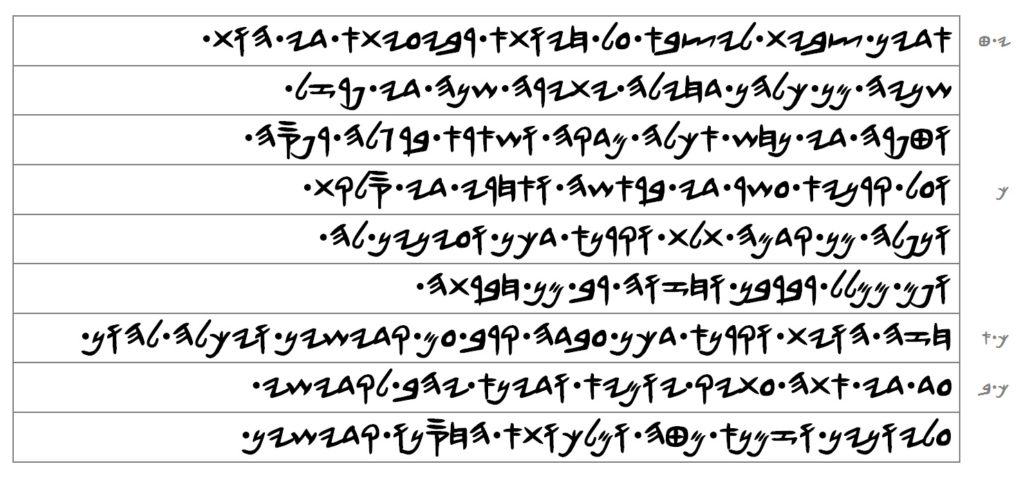
[19] Then I would know the truth about the fourth beast, the one which was different from all of the others, exceedingly terrifying, whose teeth are iron, and her nails copper; she devoured, she brakes into pieces, and the remnant by her feet she stamps.
[20] And about the ten horns which are in her head, and the other which came up, and there fell from before her three; and that horn, she had eyes and a mouth speaking great things, and her look was greater than her companions.
[21] I beheld, I saw, and that horn, she made war with the saints and she prevailed against them
[22] until He came, the Ancient One of Days, and judgment was given to the saints of the One Above All; and the time came, and the kingdom the saints possessed.
COMMENTARY OF DANAY’AL 7:19-22
[Verse 19] The angel gave Danay’al a summary breakdown of the vision in verses 17-18 but now he wants a lot more detail about that fourth beast, as if to say he didn’t care at all about the previous three beasts. It was that fourth beast that interested him the most. A new detail about the fourth beast is included in this verse that was not mentioned earlier. The fourth beast has nails of copper. This is the same metal in the belly and thighs section of the great statue of Nabo-chad-natsar (Danay’al 2:32, 39). Thus, the fourth beast incorporates and perpetuates elements of the Greek Empire.
[Verse 20] Danay’al also wanted more detail about the ten horns, and that eleventh one before whom three of the first ten fell, and who was greater and stronger looking than all the other horns.
[Verse 21] Now we learn why Danay’al was not interested in the three previous beasts. It is because none of those beasts went to war against his own people to eliminate them. Neither the Neo-Babylonian Empire, nor the Persian Empire, nor the Greek Empire were overly oppressive and dead set on destroying the people of Ya’oh-shar-al, but the little horn of the fourth beast will be, and she will prevail at doing so.
The pronouns for the little horn in the Aramaic are both feminine and masculine. This proves that the little horn is not a man but that it is rather a nation. We already know who she is. From hindsight she cannot be any other nation than the United States of America. She has fought many wars but she has only ever been waging a perpetual war against just one people from the day of her inception until this very day, i.e. her slaves, the ones that were brought by ships across the Middle Passage in chains, and their descendants who were born and raised within her borders. You are not a so-called “Israelite” by blood in the Americas unless your ancestors were forcibly driven to the shores of the Americas en masse.
[Verse 22] She will prevail against the people of Danay’al until the time arrives for the Ancient One of Days to come and render judgment in their favor. His judgment will be in the form of catastrophic natural disasters that will cast down thrones, i.e. nations, all around the world and all of their armies, the chief nation and military power being the United States of America, the daughter of Babylon.
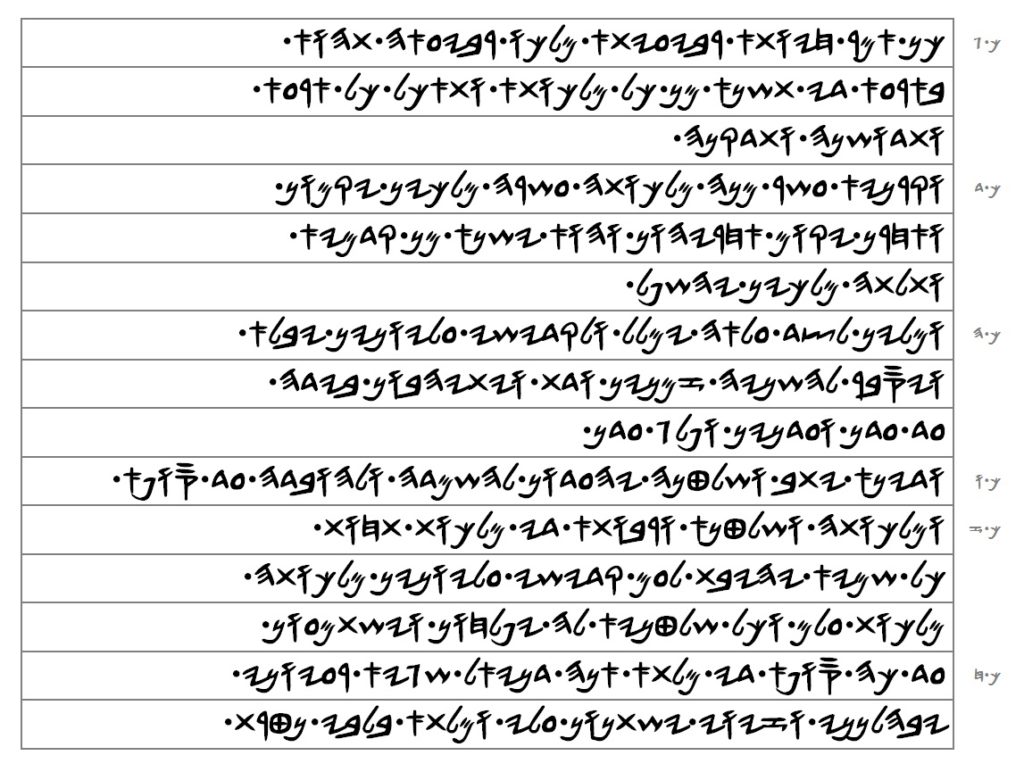
[23] Thus he said, the fourth beast, she will be the fourth kingdom upon earth, which is different from all kingdoms, and she will devour the whole earth, and she will tread it down, and she will break it into pieces.
[24] And the ten horns from out of her, a kingdom, ten kings will arise, and another will arise after them, and it will be different from the first ones, and three kings will it subdue.
[25] And words against the One Above All will it speak, and the saints of the One Above All will it wear out, and it will intend to amend times and law, and they will be given into its hand until a time, and times, and the dividing of time.
[26] But the judgment will sit, and the dominion of it will they take away, to consume and to destroy unto the end.
[27] And the kingdom, and the dominion, and the greatness of the kingdom beneath all of heaven will be given to the nation of the saints of the One Above All. His kingdom is a kingdom everlasting, and all dominions to Him will they serve, and they will obey.
[28] Until thus is the end of the word. I Danay’al, much thoughts will trouble me, and my appearance will change upon me, and the word in my heart I kept.
COMMENTARY OF DANAY’AL 7:23-28
[Verse 23-25] Danay’al already knows most of what the angel relays to him in verses 23-28. The only details that are new is that the little horn will not only wear out his people the saints, but that she will “intend to amend times and law,” and that her war against the people of Danay’al will end when the period of a “time, times, and the dividing of time” begins. The exact duration of her war against the saints is not given, but it stops when the time, times, and a half commence because she is to be destroyed at the beginning of that period.
With regards to amending “times and law,” these must have something to do with the previous clause, “and the saints of the One Above All will it wear out,” and also the clause that immediately follows, “and they will be given into its hand until…” The determination of the little horn is to wear out the people of Ya’oh-shar-al, and to keep them oppressed while they are within her hand, but at the same time not appearing to be doing so overtly and deliberately.
One way she has done this is by passing three amendments to her own law or constitution, the so-called Reconstruction Amendments. During the Reconstruction Era following the American Civil War three constitutional amendments were enacted to supposedly improve the lives of OMPP (Only Middle Passage People). The 13th Amendment abolished slavery. The 14th Amendment gave citizenship to all people born in the U.S. The 15th Amendment gave blacks the right to vote. But let us not be deceived, these amendments made the little horn look human, but in reality she remained just as much a beast to black people as she was prior to these half-hearted efforts to change “times and law”.
How did the 13th Amendment of 1865 help poor, penniless, and property-less emancipated slaves without giving them reparations to establish their own economic footing? It didn’t. It only made blacks even more dependent upon whites. They went from being slaves to being under paid and over worked employees, which is just a different kind of slave.
How did the 14th Amendment of 1868 secure for black people all of the civil rights that the white race enjoys under the law and give to the black race the protection of the government in that enjoyment? It didn’t. It only justified segregation and the absurdity of “separate but equal” public facilities in the states, the infamously racist decision by the U.S. Supreme Court in Plessy v. Ferguson (1896) that allowed the use of segregation laws by states and local governments.
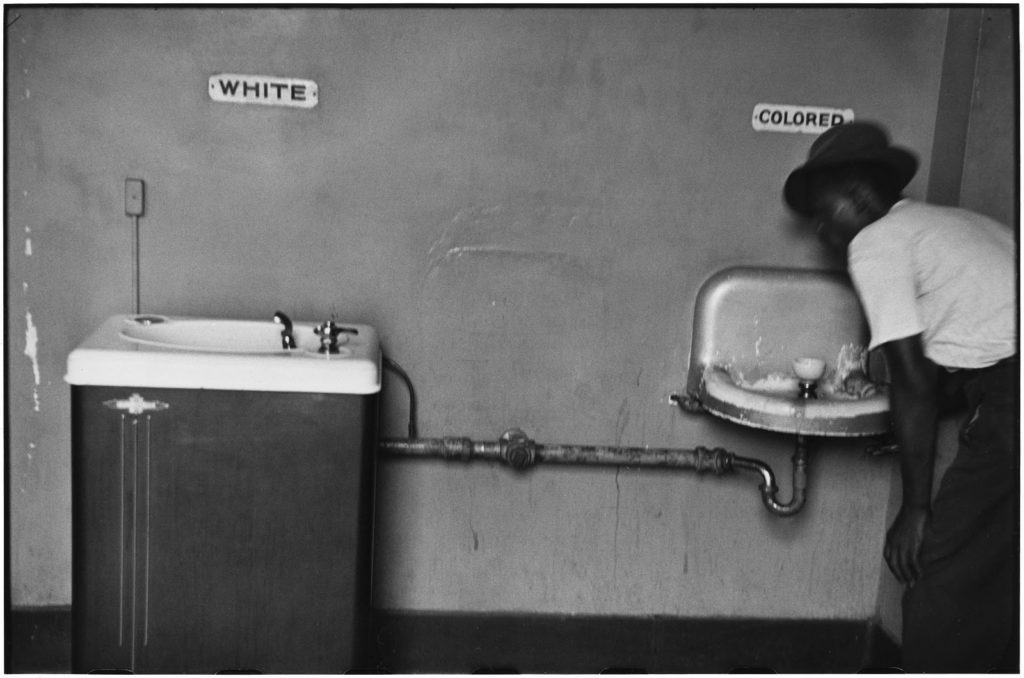
What was the point of the 15th Amendment of 1869 when despite this intended change of “times and law,” blacks residing in southern states still faced significant obstacles to voting? Jim Crow, a system of laws and attitudes that legitimized anti-black racism and the stated belief in black inferiority, was used to keep OMPP second-class citizens, in segregate public facilities, and it prevented blacks from gaining any political power for themselves whatsoever. OMPP also faced bureaucratic restrictions, such as poll taxes and literacy tests, as well as intimidation and physical violence while registering and attempting to vote.
Nothing was ever done at the federal level to enforce the Reconstruction Era laws. Thus, these amendments may have changed the history of “times and law” on paper, but they did nothing to actually improve the condition of black people in real life. In fact, in many ways they made things worse. They have allowed the little horn to continue her warfare against the saints, but without looking as if she is. She uses her mouth to talk a good game about the true spirit, meaning and intent of her amendments, and what she deems is unconstitutional, but her states and local authorities are allowed to drag things out in court for decades, thus ensuring that black people always stay oppressed, always stay economically impotent, always stay less educated, always stay in ghettos, always stay disproportionately incarcerated, and always stay behind.
The little horn’s warfare against the saints has never stopped despite the appearance that her amendments give to her constitution. Her warfare will not stop until the Exodus year is finished, when the redeemed remnant of Ya’oh-shar-al have all been gathered to the second wilderness in the east, and the day of the vengeance of YA’OH begins. The years of the wonders will last for a time, times, and a half. The exact length of a “time” (iddan) is not specified in verse 25, but since Danay’al did not ask for clarification it can only have been something he understood without it having to be explained.
Since the “time, times, and dividing of time” immediately follow the Exodus year we must see this cryptic time-span as a wilderness period. The first Exodus was followed by a wilderness period lasting forty years or one generation. So “time” (iddan) in Danay’al 7:25 is absolutely not one year. If not a year, the next unit of time to consider is a month. Although impossible for a lunar month, the perfect or ideal month is exactly four weeks or 28 days, a multiple of 7, which is in keeping with the biblical septenary (base 7) numbering system of time-measurement. The months of the calendar year are 30 or 31 days and not 28 days because a year cannot be less than fifty-two weeks or 364 days.
It is highly unlikely that Nabo-chadar-atsar (Nebuchadnezzar II) spent seven consecutive years in a mental state of insanity and that his throne was not claimed by someone else during that time but was still waiting for him afterwards (Danay’al 4:16, 25). However, it is not implausible that the king was only out of his mind for 28 days x 7 = 196 days. Thus, a “time” (iddan) in Danay’al is a unit of 28. In Danay’al 4:16 it refers to 28 days, but in Danay’al 7:25 where a wilderness period following an Exodus is in view it refers to 28 years not days. Therefore, a “time, times, and the dividing of time” in Danay’al 7:25 is 28 years x 3.5 = 98 years.
[Verses 26-27] The wonder years for a time, times, and the dividing of time will be the time when “the judgment shall sit” and the saints will take away the little horn’s dominion. Their kingdom will begin in the wilderness in the east where they fled to in order to escape the destruction of the daughter of Babylon, as commanded in Yaram-Ya’oh 51:6. When the wilderness period is finished they will transfer the kingdom to the promised land in the Levant, including all the wealth they will have amassed in the wilderness (Yashai-Ya’oh 60:9). Nations and kingdoms will serve them or perish (Yashai-Ya’oh 60:12).
[Verse 28] The tenses of the verbs in this passage indicate that some significant amount of time must had gone by from the night Danay’al saw this vision until the day he decided to make a translation of it into Aramaic. During that time his thoughts troubled him and his appearance changed. The prophet fully understood the meaning of the vision and he was evidently being tortured by its details, so much so that it became visibly apparent upon his face.
This is the same Danay’al who made an earnest intercession on behalf of his people when he realized that the seventy years for the desolations of the city of Yaroshalam were nearing their conclusion (Danay’al 9:1-19). Now he learns that his people have way more years and way more troubles ahead of them to experience, and that a nation springing forth from the fourth kingdom will make it her business to wage war against his people and she will always prevail until a certain point in history is reached. The tables will not turn in their favor until they reach the time, times, and the dividing of time.
The victory to be experienced by the people of Danay’al during the time, times, and the dividing of time was not enough to console him because he knew that day was not coming until many centuries had rolled by. However, today we rejoice because that time is upon us. We are not upset and troubled like our brother Danay’al was, and he wouldn’t be either if he were alive now. Rest easy brother. Your vision is unfolding exactly as you witnessed it. The Higher Power and your Rock who you served and who we have returned to serve with our whole heart is not allowing any of your words fall to the ground. Our Rock has name, a fearful and glorious name.
His name is YA’OH
Always has been. Always will be.
#EXODUS2023
1.15.7252 (April 5, 2023)

Shalom, shalom! Thank you for your teaching Mabane. I’m learning!
Shalom Mabane, I need one of those lions with the wings!